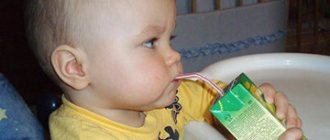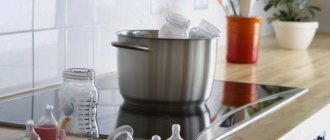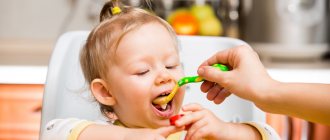At what age should you start teaching your child to drink from a glass?
Many parents, due to their misconception, do not pay attention to the age of the baby. Experts say that early involvement of a baby in meaningful activities leads to increased intellectual abilities.
- Due to the fact that a bottle with a nipple can ruin the bite, experts advise accustoming the child to a mug as soon as possible. The most optimal age for getting used to a mug is from 6 to 8 months. It is at this age that the child shows interest in surrounding objects, copying the actions of his parents. The moment of food and dishes play a special role.
- The baby already feels independent and more confident in his movements - he can sit and pick up objects. At this moment, it is important for the parent to show tolerance, involve him in the process of familiarizing himself with the necessary objects and not overreact if the baby damages the object.
We teach from six months
- Of course, you can resort to training at an earlier age, from 4 months - if good dynamics of the child’s development is visible, the baby shows interest in adults’ dishes and repeats the movements of the parents. Training should take place gradually.
- First, the child is taught to drink from a special bottle, similar to a cup with a spout or tube - a sippy cup. To make the learning process successful and easy, you need to choose the right sippy cup and follow the rules of use.
When to teach your baby to drink from a cup
In fact, if a child understands what a utensil such as a mug or cup is intended for and can hold it in his hands, it’s time to teach him the simple science of drinking like adults. Another sign that the child is ready for such training is the mobility of his fingers and the ability to sit down.
It doesn’t matter that more than one mug will be broken during the training, parents should be prepared for this, because the hands of a small child are not as obedient as those of mom or dad. He is just learning to do everything on his own, but over time his fingers will get stronger, and the baby will be quite confident in holding dishes.
Apparently, pediatricians are of the same opinion that it makes sense to accustom a baby to such utensils at 7 or 8 months. In addition, a baby at this age, as a rule, is on complementary foods and has already tried various pleasant liquids - herbal tea, juices and compotes.
Read also
To vaccinate or not to vaccinate: opinions for and against vaccination
If the baby learned to sit early, and parents can’t wait to introduce him to a cup, then we can advise them to start with sippy cups. This is a special dish that looks a little like a bottle and has a spout with a hole. It is much easier to learn with it, and later it will be time for a cup.
Doctors believe that you should not use a bottle at all if the child was completely breastfed. It also makes no sense to wait until the baby is a year old, one and a half years old or more. It will be very difficult to wean you off the bottle.
How to choose a sippy cup?
The sippy cup is easy to use - the lid and spout prevent the child from choking or spilling the contents on himself. Using a sippy cup does not disrupt the baby's teeth bite. There are many types of sippy cups: with or without a threaded lid, with or without handles, sippy cups, with spouts or a straw.
When choosing, you should pay special attention to how easily the liquid flows out - the baby should not throw back his head too much to take a sip. During the training period, several types of sippy cups may be needed, depending on the situation and their purpose.
Types of sippy cups
Children's sippy cups differ in their type, as well as in the recommended age category:
- The sippy cup for children up to 6 months consists of a silicone tip and nipple. The nozzles are replaceable - they can be alternated if necessary.
- A sippy cup is a sippy cup with a valve. When drinking, the valve opens slightly and returns to its original position when turned over.
- Thermos sippy cup. Thanks to its double walls, this sippy cup is able to maintain the temperature of the drink for the whole day. It is necessary for long winter walks in nature.
- Container with a straw – has a removable top lid into which a special drinking straw is inserted.
- A bottle with a silicone or plastic tip. Removable lids with a silicone tip are in demand - if they get dirty, they are easy to wash, and the silicone tip is more pleasant to the touch.
- A tumbler is a sippy cup made of durable material. The special shape of the bottom of the sippy cup prevents it from tipping over and spilling the drink. Suitable for active children who like to throw objects onto the floor.
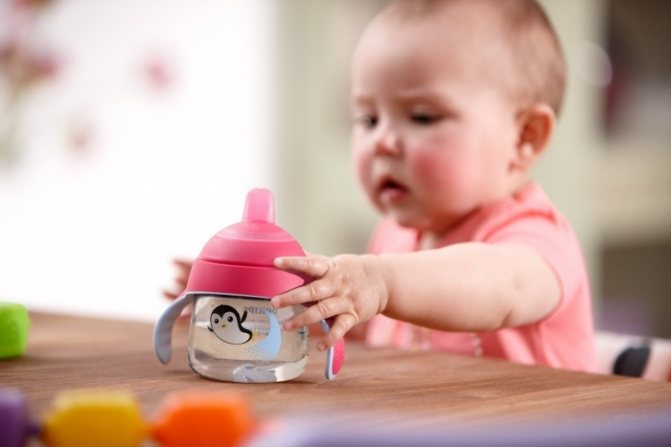
Children's sippy cups also differ in their recommended age group - this information should be indicated on the packaging. Each age group has a specific hole width, which allows you to regulate the amount of drink you swallow in one sip. Sippy cups should be considered as auxiliary utensils when transitioning to drinking from a cup.
The baby gradually weanses the habit of using a bottle with a pacifier and learns to bring the sippy cup to his mouth on his own. This capacity allows you to achieve the desired skill without additional parental care. At the same time, drinking does not cause discomfort to the baby - he remains clean and dry.
Measures for using the sippy cup
Before any use, the sippy cup should be washed thoroughly. It is also necessary to clean all removable parts every time. Make sure there are no chips or damage. If a crack is found, the sippy cup should be replaced with a new one. Do not let your child drink from a sippy cup while lying down. Do not store leftover food or drink in a sippy cup, or mix leftovers with fresh portions. The contents in the sippy cup should be age-appropriate.
Methods of accustoming to a sippy cup
You should not immediately replace the usual bottle with a nipple with a sippy cup - this can cause stress in the child and refusal to drink. You should get used to the sippy cup gradually - from time to time offering the baby to drink water or juice from it. For the first acquaintance, it is better to choose an option with a silicone spout, which feels similar to a pacifier.
So the baby won’t pay much attention to the substitution. Initially, the parent himself needs to hold and point the sippy cup upward until the baby understands the operation of this item.
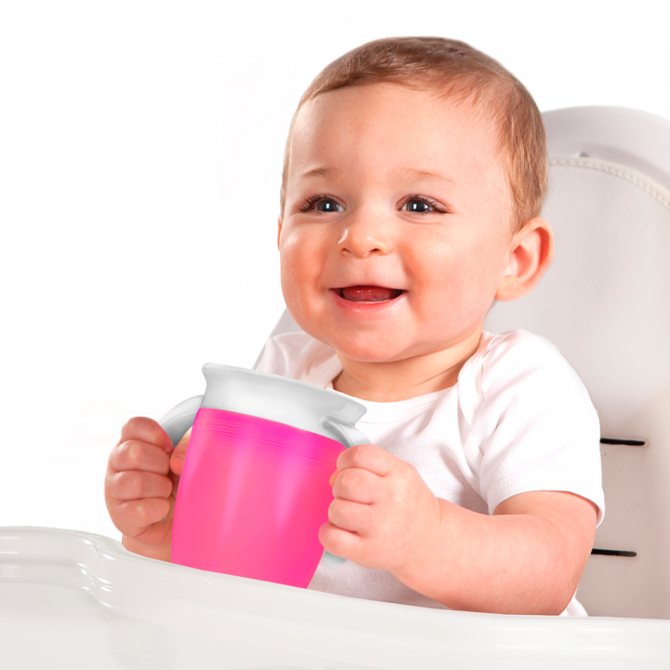
Getting used to the sippy cup
A few general tips will help speed up the process of mastering the sippy cup:
- It is necessary to awaken in the child the reflex of sucking the spout of the sippy cup. It is enough to take advantage of the child’s habit of putting everything in his mouth and let him play with the object. Another option is to offer a sippy cup spout instead of a pacifier.
- Show your child how to drink from a sippy cup by example - by drinking a little from the spout. It is advisable to conduct training in a playful way - to demonstrate pleasure from the process, the child will certainly want to copy the behavior.
- Periodically replace the bottle with nipple with a sippy cup during feeding. Pour the same amount of food into the bottle and sippy cup; when the child begins to enthusiastically absorb the mixture, alternate containers. This technique will allow the baby to appreciate the sippy cup and understand that it is no worse than a bottle with a nipple.
- It is also effective to compare the convenience of drinking from a sippy cup or a cup: the baby is first offered to drink from a cup, and after an unsuccessful attempt, they are given a sippy cup. But in this case, the main thing is not to discourage the child from using the cup in the future.
- You can also attract the child’s attention to the sippy cup through taste reflexes - moisten the nose in the mixture and let it lick. This will attract interest and help your baby understand the function of the sippy cup.
If the baby still cannot learn to drink from a sippy cup, you should make sure that the container is chosen correctly. It is necessary to give the baby the opportunity to independently choose a sippy cup in the store: invite the child to hold several different options in his hands, play with them, take a closer look at which one the baby showed the greatest interest in, and purchase this one. In this case, a more trusting contact between the child and the object is established - the sippy cup can perform not only its direct tasks, but also act as a favorite utensil. After overcoming the sippy cup, you can start drinking from a cup.
What should you pay attention to when buying a cup for your child?
The correct choice of cup determines how successful and fast the child’s learning outcome will be. It is better to choose a colorful, comfortable and lightweight cup made of unbreakable material for your first cup. You can give your baby several cups to choose from at once - he will choose the cup he likes.
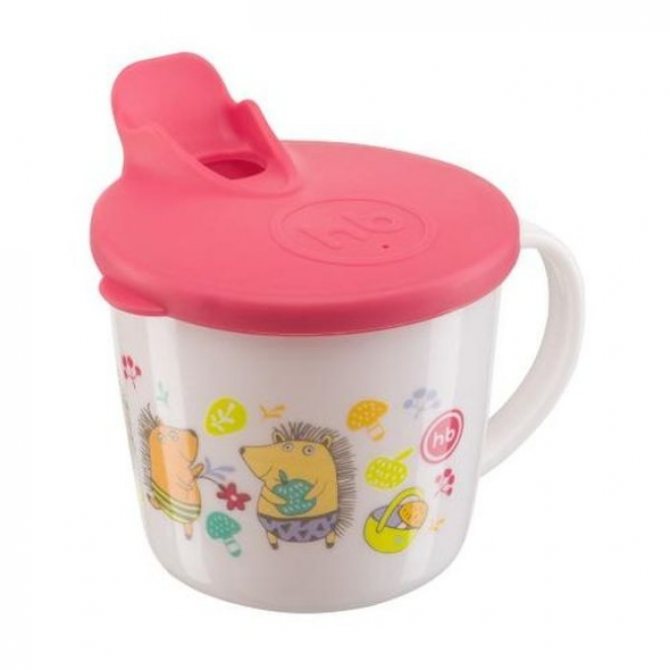
Bright cup
Key points when purchasing:
- The cup should be plastic - this will prevent chips and damage if dropped.
- Ecological materials - the product must be made from raw materials intended for use and storage of food. But you should not give preference to wooden cups or clay cups that are not covered with a protective layer - such cups are not very sterile.
- Weight and cup size – it should be taken into account that it will be difficult for the baby to hold a heavy and bulky object.
- Design – you need to pay attention to your child’s favorite fairy-tale characters. Choose a cup with familiar characters, giving preference to a bright and positive picture or color.
- Comfortable – there are cups with one or two handles. If possible, it is necessary to have both options in order to determine which one is suitable in the future.
Training methods to help teach a child to drink from a cup
To teach your baby to drink from a cup, you need to be patient, as this process takes a long time. You should not punish a child for a spilled drink - this can ruin the learning process.
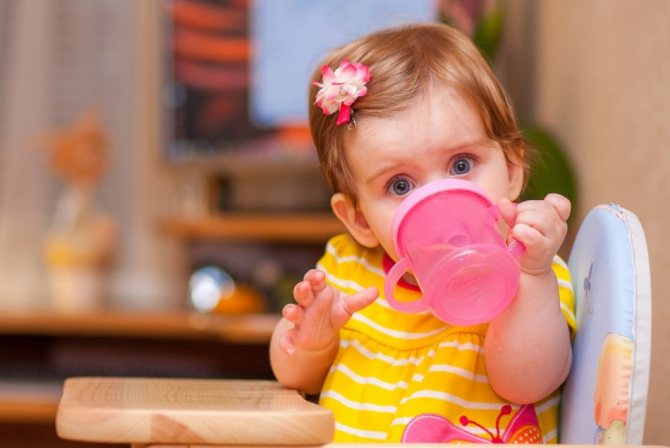
We teach
The following steps must be followed:
- Prepare everything you need to drink - fill a cup with a small amount of liquid. Considering that at first the child will spill some liquid on himself, it is better to choose plain water for classes. You cannot give hot or cold liquid, or with gases - it should not cause discomfort in the baby.
- Protect your child's clothing by wearing a bib or apron.
- Demonstrate to your baby how to hold a cup and drink from it correctly - take a few sips from your cup, and then place the cup with the drink in front of your baby's mouth.
- Do not allow your child to use a cup instead of a toy - the child must understand that the cup is only for drinking. Gently suppress the desire to knock over the cup, roll it on the table - with each attempt, put the cup aside, and then offer it to the baby again.
- It is important to choose the right time for learning - the child must be in a good mood and thirsty.
- It is necessary to help the baby - hold the cup and tilt it slightly, helping to drink. There is no need to rush - the right thing to do is to let the child take a sip and take a break. Then the baby will not get tired and will not choke.
- If the baby managed to drink from a cup, you need to praise it.
How to teach drinking from a mug
How to teach a child to get on all fours
You can teach your child to drink from a mug independently, like everything else, gradually. And it doesn’t matter whether we’re talking about a sippy cup or a regular cup without a lid. Essentially, the training is the same in both cases and is carried out in the following stages:
- First. First, the parent pours a literal sip of liquid into the cup and gives it to the child, while continuing to hold the glass in their hands for insurance. The adult’s task is to show the child exactly what needs to be done with it in order to drink. It is important to demonstrate that the mug must be tilted smoothly and slowly.
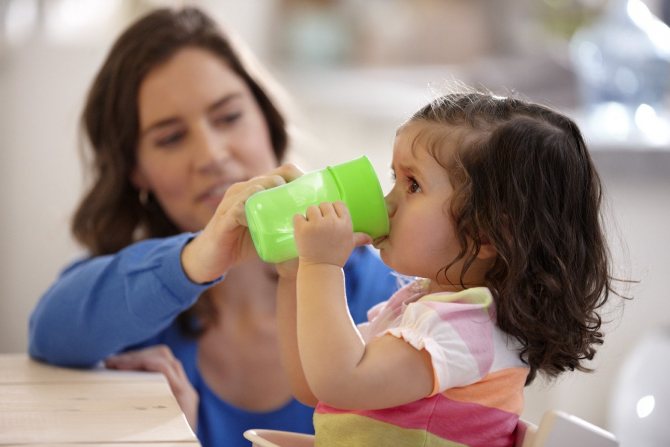
Mom teaches her daughter to drink from a cup
Important! While the baby is learning to drink, he will choke at least once. The parent is obliged to react correctly to this so that the baby does not suffocate. You need to tilt the choking person forward and use the fingertips of one hand to tap moderately hard and rhythmically on the back between the shoulder blades, closer to the neck. A similar technique is used by infant swimming specialists. You cannot hit with your palm or use force - the effectiveness of these actions is low. In addition, they can cause severe bruises.
- Second. When the baby already understands the principle of action, you can teach him to drink on his own. At this stage, you still cannot leave the child without adult supervision.
- Third. When the baby already knows how to hold and tilt the cup correctly, you can place it lower, in his access area, and also loosen control.
What difficulties might there be and how to get around them?
- The child may refuse to drink from a cup, demanding a sippy cup or bottle. In this case, you can outwit the baby’s desire: let him drink his favorite juice from a cup, and give him the juice that the baby doesn’t like from a bottle.
- It happens that the baby is afraid to drink from a cup - in this case, you can try drinking from a spoon.
- In order for a child to quickly wean himself off a bottle or sippy cup, it is necessary to remove these objects from his field of vision. As a last resort, unscrew the lid of the sippy cup - simulating a cup.
- It is better to postpone training if the baby has started teething or is feeling unwell.
- To make the child interested in the learning process, you can use toys: place a doll or animal toy next to him, show him how to give the toy a drink, and let the child try to give it a drink himself. This form of play allows the baby to quickly understand how to drink from a cup correctly and that it is not at all scary.

. Do not be upset if you cannot accustom your baby to a cup within the allotted age period; this process is individual for each child. But training should not be ignored completely. The misconception is that the older the child, the easier it is for him to break the habit.
When can you start training?
It is better to start teaching your baby to drink from a mug as soon as you wean him off the breast. So, already at 7-8 months you can teach your child to drink from a mug .
It is necessary to choose a beautiful, light and unbreakable mug, but it is better for the child to choose it himself.
As a transitional means, you can use a special sippy cup. It is convenient when it is time for a child to wean off a bottle, but he has not yet learned to drink from a mug. It is not advisable to delay with the sippy cup. As soon as the child learns to drink from it, you need to move on to learning to drink from a regular mug. The sooner a child starts learning, the sooner he will succeed.
Where to start studying
Sippy cup
When you have already chosen a suitable cup (mug) that your child likes, you can try giving him some water. You can pour one or two sips and bring it to his mouth. Lean over and let him take a sip. Be sure to do this when the child is in a great mood, so that he does not subsequently have negative memories when he sees the cup.
Don’t get angry yourself if your baby doesn’t succeed. The first time is enough for him to understand what the mug is for. His desire to look at a new object for him, to touch and play, should not be hindered.
Remember that a child at this age understands well when you praise him and when you reprimand him.
- It's okay if he spills water. Please try again later.
- Give him what he likes to drink most (juice, compote, jelly...).
- You can offer him a drink when he is in the bathroom. For him, this is a comfortable environment and there is no danger that he will spill the drink on himself.
- Give him a break while drinking, and if he does not open his mouth, then never try to force the liquid in.
Say goodbye to the bottle forever
Hide the bottle and he will soon forget about it.
When he gets thirsty, bring him a mug and let him know that this is the only way he will drink from now on. If the desire to drink from a bottle reaches hysteria, and you cannot calm him down, use a trick:
Pour the drink he doesn’t like into a bottle, and pour his favorite juice into a cup. In this case, he will most likely prefer a cup.
If it works, then don’t show the bottle to your baby again. He must learn that drinking from a cup tastes better, and there is no alternative. At first, you can drink from a bottle only before bedtime.
Learning consistently
The baby may not drink enough of the drink from the cup and begin to be capricious. You can wait a little and let him take a sip again. You can let him drink from the spoon, but in no way return to feeding through the pacifier. Otherwise, you will have to start all over again. The child will not get used to drinking right away; it takes time. But by training it consistently, you will achieve positive results very quickly.



